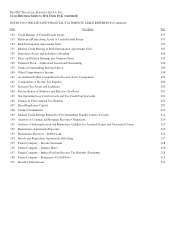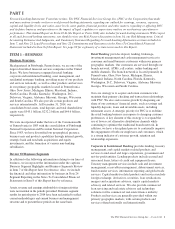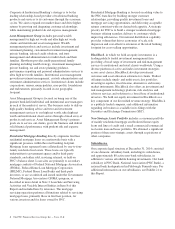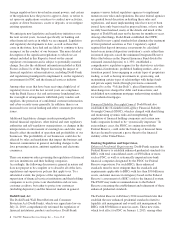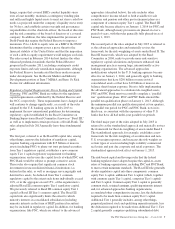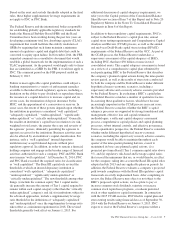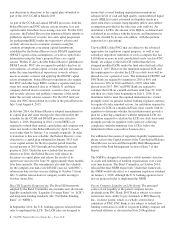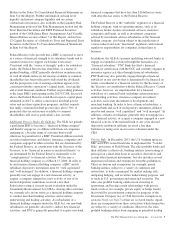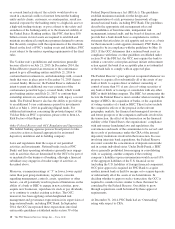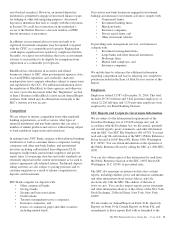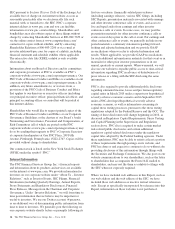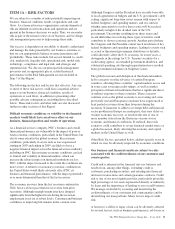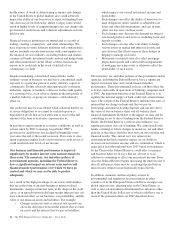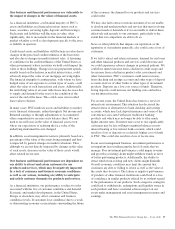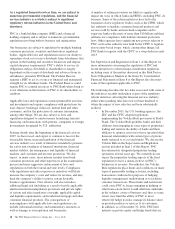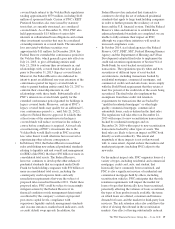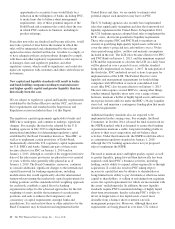PNC Bank 2014 Annual Report Download - page 28
Download and view the complete annual report
Please find page 28 of the 2014 PNC Bank annual report below. You can navigate through the pages in the report by either clicking on the pages listed below, or by using the keyword search tool below to find specific information within the annual report.
or covered fund activities if the activity would involve or
result in a material conflict of interest between the banking
entity and its clients, customers, or counterparties, result in a
material exposure by the banking entity to a high-risk asset or
a high-risk trading strategy, or pose a threat to the safety and
soundness of the banking entity or to the financial stability of
the United States. Banking entities, like PNC, that have $50
billion or more in total assets are required to establish and
maintain an enhanced compliance program designed to ensure
that the entity complies with the requirements of the final rule.
Based on the level of PNC’s trading assets and liabilities, PNC
is not subject to the metrics reporting requirements of the final
rules.
The Volcker rule’s prohibitions and restrictions generally
become effective on July 21, 2015. In December 2014, the
Federal Reserve granted an extension of the conformance
period to give all banking entities until July 21, 2016 to
conform their investments in, and relationships with, covered
funds that were in place prior to December 31, 2013 (legacy
covered funds). Moreover, the Federal Reserve indicated its
intent to grant an additional one-year extension of the
conformance period for legacy covered funds, which would
give banking entities until July 21, 2017 to conform their
ownership interests in, and relationships with, legacy covered
funds. The Federal Reserve also has the ability to provide up
to an additional 5-year conformance period for investments
held as of May 1, 2010 in qualifying illiquid funds. For
additional information concerning the potential impact of the
Volcker Rule on PNC’s operations, please refer to Item 1A
Risk Factors of this Report.
Other Federal Reserve and OCC Regulation and Supervision.
The federal banking agencies possess broad powers to take
corrective action as deemed appropriate for an insured
depository institution and its holding company.
Laws and regulations limit the scope of our permitted
activities and investments. National banks (such as PNC
Bank) and their operating subsidiaries generally may engage
only in activities that are determined by the OCC to be part of
or incidental to the business of banking, although a financial
subsidiary may engage in a broader range of activities as
described above.
Moreover, examination ratings of “3” or lower, lower capital
ratios than peer group institutions, regulatory concerns
regarding management, controls, assets, operations or other
factors, can all potentially result in practical limitations on the
ability of a bank or BHC to engage in new activities, grow,
acquire new businesses, repurchase its stock or pay dividends,
or to continue to conduct existing activities. The OCC,
moreover, has been applying certain heightened risk
management and governance expectations in its supervision of
large national banks, including PNC Bank. In September
2014, the OCC incorporated these expectations into final
enforceable guidelines established under section 39 of the
Federal Deposit Insurance Act (FDI Act). The guidelines
establish minimum standards for the design and
implementation of a risk governance framework at large
insured national banks, including PNC Bank. The guidelines
describe the appropriate risk management roles and
responsibilities of front line units, independent risk
management, internal audit, and the board of directors, and
provide that a bank should have a comprehensive written
statement that articulates its risk appetite and serves as a basis
for the framework (a risk appetite statement). PNC Bank is
required to be in compliance with the guidelines by May 10,
2015. If the OCC determines that a national bank is not in
compliance with these or other guidelines established under
section 39 of the FDI Act, the OCC may require the bank to
submit a corrective action plan and may initiate enforcement
action against the bank if an acceptable plan is not submitted
or the bank fails to comply with an approved plan.
The Federal Reserve’s prior approval is required whenever we
propose to acquire all or substantially all of the assets of any
bank or thrift, to acquire direct or indirect ownership or
control of more than 5% of any class of voting securities of
any bank or thrift, or to merge or consolidate with any other
BHC or thrift holding company. The BHC Act enumerates the
factors the Federal Reserve must consider when reviewing the
merger of BHCs, the acquisition of banks, or the acquisition
of voting securities of a bank or BHC. These factors include
the competitive effects of the proposal in the relevant
geographic markets; the financial and managerial resources
and future prospects of the companies and banks involved in
the transaction; the effect of the transaction on the financial
stability of the United States; the organizations’ compliance
with anti-money laundering laws and regulations; the
convenience and needs of the communities to be served; and
the records of performance under the CRA of the insured
depository institutions involved in the transaction. In cases
involving interstate bank acquisitions, the Federal Reserve
also must consider the concentration of deposits nationwide
and in certain individual states. Under Dodd-Frank, a BHC
also is generally prohibited from merging or consolidating
with, or acquiring, another company if the resulting
company’s liabilities upon consummation would exceed 10%
of the aggregate liabilities of the U.S. financial sector
(including the U.S. liabilities of foreign financial companies).
OCC prior approval is required for PNC Bank to acquire
another insured bank or thrift by merger or to acquire deposits
or substantially all of the assets of such institutions. In
deciding whether to approve such a transaction, the OCC is
required to consider factors similar to those that must be
considered by the Federal Reserve. Our ability to grow
through acquisitions could be limited by these approval
requirements.
At December 31, 2014, PNC Bank had an “Outstanding”
rating with respect to CRA.
10 The PNC Financial Services Group, Inc. – Form 10-K


